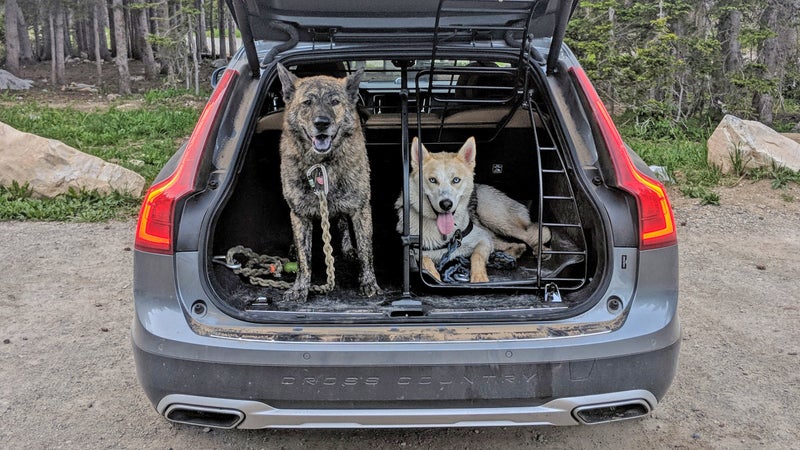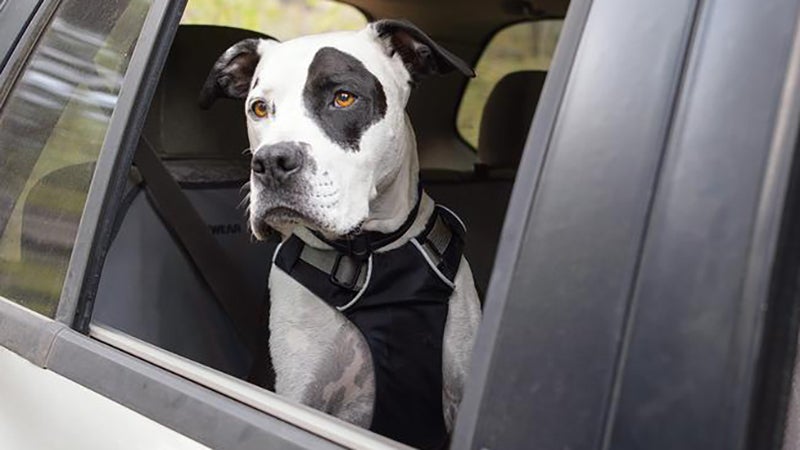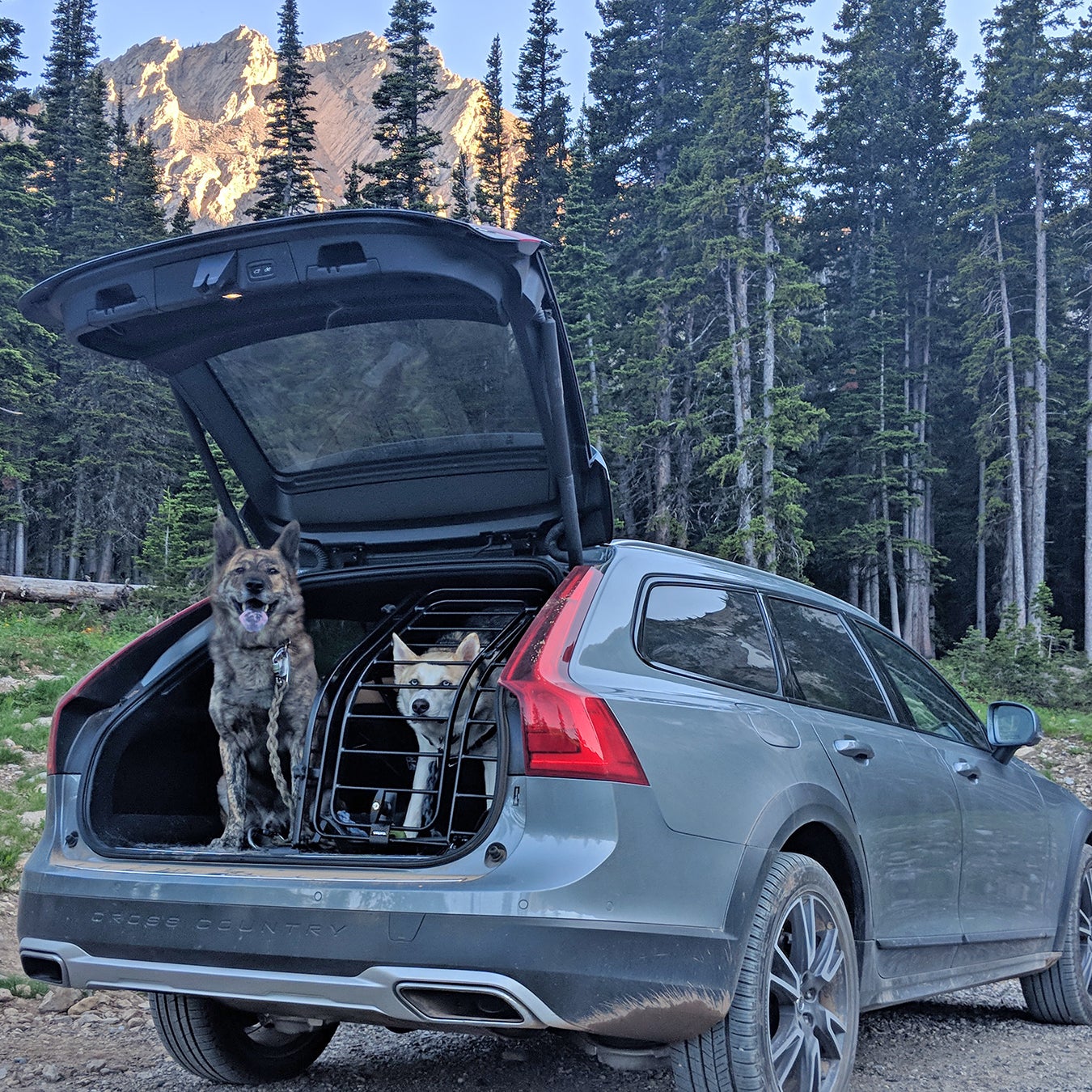In a car crash at 35 miles per hour, an unrestrained 60-pound dog becomes a 2,700-pound projectile. The force of that impact could kill both the dog and the car’s human occupants. Yet many of us drive around every day with our dogs just sitting on the back seat, or even on our laps.
“Securing a dog is kind of like buying a fire extinguisher,” says Patrick Kruse, the founder and R&D director of Bend, Oregon–based dog gear brand Ruffwear. “Most of us don’t plan on testing a dog safety harness, but if you ever do, it really becomes apparent that having a dog restrained is a good thing.”
I own two dogs and regularly drive with them in the car. Given their roughly 15-year life span, odds are that at some point in their lives, we will have an accident while driving together. I’d like them to survive such a circumstance, so I set about researching how I could keep them safe.
Kruse has been designing harnesses, backpacks, and other products for active dogs for 24 years. In 2013, he began designing a product that could save dogs from injury in car crashes. Ruffwear’s resulting Load Up safety harness was a pioneering product and remains the industry leader when it comes to in-car dog safety.
Kruse describes three main things you need to consider for keeping your dog safe when driving: preventing distractions, managing the dog’s deceleration rate upon impact, and keeping the dog restrained post-crash. All that needs to be achieved with speed and convenience if you’re actually going to bother using the system every time you load a dog into the car. Plus, the system needs to be comfortable for the dog.
Going into this research, I wasn’t aware of the importance of making sure a dog is restrained in the aftermath of an accident. But it makes sense. Kruse told me stories of dogs panicking and fleeing accidents through a broken window, only to be lost or hit by incoming traffic. He also explained that sometimes a panicked dog may delay treatment for its incapacitated owner. “With a rattled dog, some emergency responders are saying that they can’t get access to the human because the dog won’t let them get close,” he says.

Probably the easiest way to secure a dog in a car is with a divider between the back seat and the load area of a wagon or SUV. Just load the dog into the back of the car, and it’s contained in a safe area, away from the human occupants. A crate takes containment one step further and would work even if the rear window gets broken in an event like a rollover. Of course, not all dividers and crates are created equally. Many load dividers install only under tension and are built from flimsy materials. Kruse recommends looking for one that bolts to the frame of the car. “If you can rip the thing out with your hands, it’s probably not going to sustain an impact,” he says.
He gives a similar warning about plastic travel crates. “If you’re strapping something down that’s supposed to take a 2,700-pound hit, but it’s made from plastic you can kick in with your foot, it’s probably not going hold up in a crash,” Kruse says. The Center for Pet Safety recommends the Gunner Kennel G1.
Dividers and crates may help keep human occupants safe from flying dogs in a crash, as well as help keep dogs safely inside the vehicle, but they do nothing to actually protect the dog during the crash. “We don’t die from the car crash,” Kruse says. “We die from what’s called third-space impact. The car hits a brick wall—that’s the first-space impact. Your chest hits the steering wheel—that’s the second space. Your internal organs hit your rib cage—that’s the third space, and that’s where the damage is done. If you’ve got a dog in a crate, and they’re bouncing around like a marble inside that crate, then the damage is being done.”
The trick is to manage the deceleration rate of the animal in question—be it human or canine—which means decreasing the force with which the heart, spleen, brain, or other organs get squashed against something hard. That’s what seatbelts and airbags do for humans, but until the past few years, there was no such product available for dogs, no standards defining what these products should set out to achieve, and no procedures for testing them.
That all changed in 2011, when New Jersey made it a violation of its animal cruelty laws to carry your dog unrestrained in your car. That helped create demand for effective dog restraints. That same year, Lindsey Wolko, whose dog had been injured by an ineffective restraint, founded the Center for Pet Safety. Wolko realized that without a testing methodology, there could be no assurance of effectiveness, and without that assurance, consumers could not know which products would work and which ones wouldn’t.
This video shows a compendium of products failing the CPS test.
The Center for Pet Safety (CPS) adopted Federal Motor Vehicle Standard 213 (FMVS 213), which regulates child-restraint systems, as its guide and developed a methodology for testing dog restraints to that standard. The initial results on existing products were eye-opening. Of the devices it tested, 100 percent failed. CPS lists four problems it found in that initial batch of testing:
- Extremely low likelihood of survivability for the animal.
- Danger to humans when the dog becomes a missile.
- Choking and/or other bodily harm to the animal when harness materials cinch tightly upon impact.
- Extensive damage to fixtures within the vehicle caused by the projectile animal.
“The dog would actually slingshot or cantilever through those systems, becoming entangled, and in some cases rip parts off the crash-test mannequin as it was catapulted through the windshield,” says Kruse, who would eventually use the CPS’s test center and methodology to develop his Load Up harness.
By employing FMVS 213 in its testing, CPS’s major concern is keeping the dog from hitting the back of the front seats. (Dog safety harnesses are designed to attach to the seatbelts in the back seat.) So it’s no coincidence that the most effective harness ended up being one designed to hold a dog in the same position as a child sitting in its car seat. Kruse describes this approach as “human-centric” and expresses concerns about how convenient such a system would be for a human to load a dog into and how comfortable such a device would be for a dog to ride in. It’s also limited in its ability to handle dogs that are larger than a human child.
Kruse already knew how to design a dog harness—he’d been doing it for 24 years. But here he had to figure in much greater forces than those that a climbing or pack harness would ever have to deal with. He spec’d thicker nylon webbing and metal buckles rated to thousands of pounds of force. But where to attach the seatbelt? In CPS’s testing, Kruse saw that attachment points between the shoulder blades were effective at keeping dogs from colliding with the seats in front of them, but they were also flipping dogs over and directing forces through their bodies in unnatural ways. Watch the testing video above and you’ll see exactly that occur. Harnesses that eventually received the CPS certification are stronger and limit the dog’s forward travel but still violently flip them over.
“If they jump off a high rock and onto the ground, the dog’s internal organs are supported by the chest or rib cage,” Kruse says. “Most of the power of a dog is developed through the front legs, and they support the bulk of that up in their chest area.” He found that the most effective way to correctly support a dog was to pull through its chest and back toward its tail, so Kruse placed the seatbelt attachment for the harness back between the hips, over the tail. The elasticity of the nylon webbing and the padding in the harness then provide the deceleration essential to making the crash survivable, and the dog remains in the proper orientation throughout the crash.

One problem: In this biomechanically ideal position, there isn’t enough room in the back seat to prevent larger dogs from hitting the front seat. “When you put a 120-pound malamute in the back of a Subaru, their chin comes to your forehead,” Kruse says. “They’re already in contact with the back of the front seats, just due to the size of the dog.”
For that reason, Kruse’s Load Up harness passed the CPS tests in sizes small and medium (dogs up to 32 inches in girth behind their front legs) but failed in larger sizes because it allows big dogs to come into contact with those front seats. You can find a list of CPS-certified products here.
Despite his design’s lack of CPS certification, Kruse still believes it represents the best possible solution, given the limited space inside passenger cars. He explains, “We’re keeping the dog from rattling around inside the car. We’re keeping the dog from going out the windshield. In the event of a rollover where the windows get broken out, the dog is restrained and not running away. It’s not just whether or not your dog gets a bloody nose from impacting the seat—it’s all these things.”
But, Kruse laments, “We’re building cars for humans, not dogs.” Currently, there’s no way to support a larger dog in the way Kruse believes is ideal while keeping them from slamming against the front seats in a crash. Keeping your large dog safe is a compromise between their body shape and the limited space inside your car.
Until someone designs a car with dog safety in mind, this is the best we can hope for. If you want to keep your dog safe in your car, then a harness like the Ruffwear Load Up is your best option.

